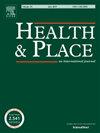Combined associations of takeaway food availability and walkability with adiposity: Cross-sectional and longitudinal analyses
IF 4.1
2区 医学
Q1 PUBLIC, ENVIRONMENTAL & OCCUPATIONAL HEALTH
引用次数: 0
Abstract
Background
Diet and physical activity are important determinants of energy balance, body weight and chronic health conditions. Peoples’ health and behaviour are shaped by their environment. For example, the availability of unhealthy takeaway food in residential neighbourhoods and the ability to easily walk to a range of local destinations (high “walkability”) influence diets and physical activity levels. Most existing evidence on the associations between residential neighbourhood and adiposity is cross-sectional and examines either walkability or takeaway availability, but not both in combination.We examined the cross-sectional and longitudinal associations of residential neighbourhood walkability and takeaway food availability with markers of adiposity separately and combined.
Methods
With data from the Fenland Study (Cambridgeshire, UK; n = 12,435), we used linear regression to estimate associations for walkability and takeaway availability separately and in mutually adjusted models, in addition to combining both into a measure of neighbourhood supportiveness for active living and healthy eating. Objective measures of BMI were examined cross-sectionally at baseline (2005–2015) and as change between baseline and follow-up (2014–2020). Additional outcomes (percentage body fat, waist circumference and hip circumference) were also examined both cross-sectionally and longitudinally.
Results
Complete case analyses indicated that neighbourhoods with greater walkability and lower takeaway availability were associated with lower BMI (n = 10,607) and more favourable trends over time (n = 5508). For example, compared with the lowest exposure group (Q1), Q4 of walkability and takeaway food availability was associated with a difference in BMI of −0.69 kg/m2 (95% CI = −1.09 to −0.29) and 0.99 kg/m2 (95% CI = 0.58 to 1.39) respectively. These associations were more consistent when both neighbourhood measures were included in mutually adjusted models. The combined supportiveness measure was associated with lower BMI. High walkability and low takeaway availability were also associated with lower body fat percentage, waist circumference and hip circumference.
Conclusions
These findings are consistent with the residential environment having a role in shaping people's health and behaviour. Living in an area that supports walking and cycling and affords less access to unhealthy food may support people to maintain a healthy lifestyle. It was important to consider walkability and takeaway food availability together because to examine them separately risks unobserved confounding by the other. Future research could incorporate additional environmental measures, especially those likely to be correlated.
外卖食品可得性和步行性与肥胖的综合关联:横断面和纵向分析。
背景:饮食和身体活动是能量平衡、体重和慢性健康状况的重要决定因素。人们的健康和行为受到环境的影响。例如,在居民区提供不健康的外卖食品以及能够轻松步行到一系列当地目的地(高“可步行性”)影响饮食和身体活动水平。大多数关于居民区与肥胖之间关系的现有证据都是横断面的,要么考察步行性,要么考察外卖的可得性,但没有将两者结合起来。我们分别和联合研究了居民区步行能力和外卖食品供应与肥胖标志物之间的横断面和纵向关联。方法:数据来自芬兰研究(Cambridgeshire, UK;N = 12,435),我们使用线性回归分别估算步行性和外卖可用性的关联,并在相互调整的模型中进行评估,此外,我们还将两者结合起来,衡量社区对积极生活和健康饮食的支持程度。在基线(2005-2015年)和基线与随访(2014-2020年)之间横断面检查BMI客观测量值。其他结果(体脂百分比、腰围和臀围)也被横向和纵向检查。结果:完整的案例分析表明,可步行性较高和外卖可用性较低的社区BMI较低(n = 10,607),并且随着时间的推移趋势更有利(n = 5508)。例如,与最低暴露组(Q1)相比,Q4的可步行性和外卖食品可获得性与BMI差异分别为-0.69 kg/m2 (95% CI = -1.09至-0.29)和0.99 kg/m2 (95% CI = 0.58至1.39)。当两种邻里测量都包含在相互调整的模型中时,这些关联更加一致。联合支持测量与较低的BMI相关。高步行率和低外卖率也与较低的体脂率、腰围和臀围有关。结论:这些发现与居住环境在塑造人们的健康和行为方面的作用是一致的。生活在一个支持步行和骑自行车以及较少接触不健康食品的地区,可能有助于人们保持健康的生活方式。同时考虑可步行性和外卖食品的可获得性是很重要的,因为分开检查它们可能会造成未被观察到的混淆。未来的研究可以纳入更多的环境措施,特别是那些可能相关的措施。
本文章由计算机程序翻译,如有差异,请以英文原文为准。
求助全文
约1分钟内获得全文
求助全文
来源期刊

Health & Place
PUBLIC, ENVIRONMENTAL & OCCUPATIONAL HEALTH-
CiteScore
7.70
自引率
6.20%
发文量
176
审稿时长
29 days
期刊介绍:
he journal is an interdisciplinary journal dedicated to the study of all aspects of health and health care in which place or location matters.
 求助内容:
求助内容: 应助结果提醒方式:
应助结果提醒方式:


